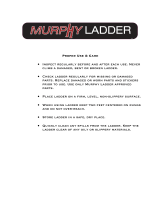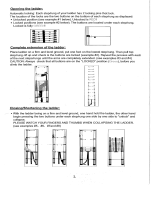Page is loading ...

SELECTION GUIDE INSPECTION INSTRUCTIONS
INSTRUCTIONS INSPECTION SELECTION GUIDESELECTION GUIDE
SELECTION GUIDE
HOW TO SELECT A LADDER
HOW TO SELECT A LADDER (CONTINUED)
LADDER
SIZE
APPROX.
HIGHEST
STANDING
LEVEL
MAXIMUM
REACH
^
4’ 1’ 11” 8’ 6”
5’ 2’ 10” 9’ 5”
6’ 3’ 9” 10’ 4”
7’ 4’ 9” 11’ 4”
8’ 5’ 8” 12’ 3”
10’ 7’ 7” 14’ 2”
12’ 9’ 6” 16’ 1”
14’ 11’ 5” 18’
16’ 13’ 4” 19’ 11”
18’ 15’ 3” 21’ 10”
20’ 17’ 2” 23’ 9”
STEP LADDERS
LADDER
SIZE
MAXIMUM
EXTENDED
LENGTH
MAX.
REACH
^
WORKING
RANGE
TO TOP
SUPPORT*
MAXIMUM
ACCESSIBLE
ROOF HEIGHT
RANGE*
16’ 13’ 16’ 1” 7 ½’ – 12 ½’ 4 ½’–9 ½’
20’ 17’ 20’ 9 ½’ – 16 ½’ 6 ½’–13 ½’
24’ 21’ 23’ 10” 11 ½’ – 20’ 8 ½’–17’
28’ 25’ 27’ 9” 13 ½’ – 24’ 10 ½’–21’
32’ 29’ 31’ 7” 15 ½’– 28’ 12 ½’–25’
36’ 32’ 34’ 6” 17 ½’ – 31’ 14’–28’
40’ 35’ 37’ 5” 19’ – 33 ½’ 16’–30 ½’
44’ 39’ 41’ 3” 21’ – 37 ½’ 18’–34 ½’
48’ 43’ 45’ 2” 23’ – 41 ½’ 20’–38 ½’
60’ *
48’ 50’ 23’ – 46 ½’ 20’–43 ½’
EXTENSION LADDERS
^Assumes 5’ 7” person with 12” vertical reach |
*When set up at the proper 75 1/2° angle | **Three–section extension ladder
The most versatile
style of ladder,
found in a variety
of sizes. Most
commonly used for
higher elevations.
Combine step
ladder and
warehouse ladder
technology. The
non-pinch platform
provides a large
standing area for
work.
Allows two users
to work on the
same ladder
simultaneously.
Easily accomplish
tasks that would be
more dicult for a
single person.
The most popular
style of ladder.
Used from medium
to low heights.
Utilize pail shelves
and tops to hold
tools for the job.
STEP LADDER TWIN FRONT LADDER PLATFORM LADDER
EXTENSION LADDER
1
Select a TypeSelect a Type
3
Select a
Load Capacity
Select a
Load Capacity
4
Select a
Ladder Material
Select a
Ladder Material
2
Select a HeightSelect a Height
TYPE III:
Household use. Light
duty. Capable of
supporting 200 lbs.
USES: Light cleaning
and painting.
TYPE IA: Professional
use. Extra heavy duty.
Capable of supporting
300 lbs.
USES: Roong,
building maintenance,
contracting and
industrial construction.
TYPE I:
Industrial use. Heavy
duty. Capable of
supporting 250 lbs.
USES: Building
maintenance, general
contracting and
sheet rock.
TYPE II: Commercial
use. Medium duty.
Capable of supporting
225 lbs.
USES: Light commercial
and general repair,
painting and cleaning.
TYPE IA A: Professional
use. Extra heavy duty.
Capable of supporting
375 lbs.
USES: MRO and
industrial construction.
IIIIII
TYPETYPE
LOAD CAPACITYLOAD CAPACITY
includes weight of user
plus materials
200200
lbslbs
IAIA
TYPETYPE
includes weight of user
plus materials
LOAD CAPACITYLOAD CAPACITY
lbslbs
300300
II
TYPETYPE
LOAD CAPACITYLOAD CAPACITY
includes weight of user
plus materials
lbslbs
250250
250250
IIII
TYPETYPE
LOAD CAPACITYLOAD CAPACITY
includes weight of user
plus materials
225225
lbslbs
IAAIAA
TYPETYPE
lbslbs
375375
LOAD CAPACITYLOAD CAPACITY
includes weight of user
plus materials
> Non-conductive when clean
and dry
> Strong and durable
> Weather-resistant
> Great for heavy-duty
construction
FIBERGLASS
FIBERGLASS LADDERS
ARE SAFE FOR WORKING
AROUND ELECTRICITY
ALUMINUM
> Lightweight
> Long-lasting construction
> Resists corrosion
> Ideal for painting, roofing
and siding
DO NOT USE
ALUMINUM
LADDERS NEAR
ELECTRICITY
Louisville Ladder, Inc. manufactures products in ompliance with the
applicable safety codes of the AMERICAN NATIONAL STANDARDS
INSTITUTE (ANSI). There are a variety of ANSl safety codes depending on material and
type of ladder. You can nd a list of them in the gure on the right.
In addition, ANSI codes have established a Duty Rating which identies the use for which
a portable ladder is intended and the conditions under which the ladder can be used
safely. An extensive series of tests and design requirements determines which Duty Rating
label a particular ladder may receive. The total load supported includes the combined
weight of the user, clothing, tools and any materials on the ladder. However, ladders must
be used properly in order to support the intended load.
AT LOUISVILLE LADDER, all of our products are designed and constructed to meet
or exceed applicable standards and requirements of the American National Standards
Institute (ANSI), Occupational Safety and Health Administration (OSHA), and Canadian
Standards Association (CSA). Please read the information on this page before using
our products. Your safety is important to us.
METAL LADDERS: ANSI A14.2
FIBERGLASS LADDERS: ANSI A14.5

SELECTION GUIDE INSPECTION INSTRUCTIONS
INSTRUCTIONS INSPECTION SELECTION GUIDESELECTION GUIDE
SELECTION GUIDE
HOW TO SELECT A LADDER (CONTINUED)
The OCCUPATIONAL SAFETY & HEALTH ADMINISTRATION (OSHA)
regulates the adequacy of ladders and the work practices followed by
employees using them in ve sections: Portable Wood (1910.25), Portable Metal (1910.26),
Fixed Ladders (1910.27), Mobile Ladder Stands and Scaffolds (1910.29) and ladders used in
Construction Industry (1926.1053). These sections specify the standards to which all portable
ladders must be manufactured, care and placement of ladders in the workplace, and the safe
use of ladders on the job.
OSHA sets minimum national requirements with respect to the use of ladders in business
and industry. However, many states have enacted their own regulations under the
Occupational Safety & Health Act that establish more severe requirements. The more
demanding state codes will supersede OSHA standards within their respective states.
Therefore, users should check with their own state OSHA representatives.
Where applicable, product meets or exceeds
CANADIAN STANDARDS INSTITUTE testing requirements.
=
Look for damaged or missing parts
Always check for damage before using any ladder. Do not use a damaged ladder.
Conduct your inspection before you leave for the job site.
1. Begin at the bottom, making sure the feet are not broken or malfunctioning and that
the slip-resistant pads are secure.
2. Inspect the ladder for cracks, bends, and splits on side rails, rungs, and steps.
3. Check all rung/step-to-side rail connections, as well as hardware, fittings, and
accessories. Make sure both rung locks are in working order.
4. Test the rope and pulley for smooth operation. Replace the rope if frayed or partially
cut.
5. All pivotal connections and the rung-locks should be well-lubricated.
6. All bolts and rivets should be secure. Never use a ladder if any bolts or rivets are
missing or if the joints between the steps (or rungs) and the side rails are not tight.
7. Make sure the ladder (particularly the steps and rungs) is free of foreign materials
such as oil and grease.
8. If you’re using a stepladder, make sure the spreader braces are not bent, are secure
and working properly.
Use a ladder-inspection chart as a guide for evaluating the safety of a ladder.
Remember to inspect the ladder before you travel to the job site, because once
you’re there you’ll be tempted to use the ladder regardless of its condition.
Always mark unsafe ladders by using a damaged-ladder tag (see sample illustration).
Be sure to store damaged ladders away from usable
ladders. Have them repaired as soon as possible.
Destroy unrepairable ladders immediately.
Transporting a ladder
Accidents can happen while transporting the ladder
to the job site. A ladder is long and awkward, and
can cause injuries and property damage during
transport. When possible, two people should carry
an extension ladder. If you carry it yourself, keep
the front end of the ladder slightly higher than the
back end.
Never move or reposition an extension ladder
without completely retracting the fly section.
Failure to do so can cause serious injury or
death.
Secure both ends of a ladder when transporting it on
a vehicle. Use care when placing ladders onto or
removing from ladder racks.
LADDER INSPECTION

SELECTION GUIDE INSTRUCTIONS
INSTRUCTIONS SELECTION GUIDE
INSPECTION
SELECTION GUIDE
INSPECTION
INSTRUCTIONS- EXTENSION LADDER (CONTINUED)INSTRUCTIONS- EXTENSION LADDER (CONTINUED)
Consider before each use
1. Metal ladders conduct electricity. Keep away form electrical circuits.
2. Consult manufacture for use in chemical or other corrosive environments.
3. Use a ladder only as outlined in instructions. Ladders are designed for one person
only. DO not overload.
4. DO not use in high winds or during storms.
5. DO not use in poor health, if taking drugs or alcoholic beverages, or if physically
handicapped.
6. Keep shoes clean. Leather soles should not be worn.
7. Never leave ladder set up and unattended.
8. Pay close attention to what you are doing.
9. Use this product at your own risk.
Proper set-up and use
1. Use help in setting up multi-purpose ladder, if possible.
2. Make sure ladder id fully open and hinges locked.
3. Set all feet on firm level surface. Do not place on unstable, loose, or slippery surfaces. Place
multi-purpose ladders where access is not obstructed. Do not place in front of unlocked doors.
multi-purpose ladders are not intended to be used on scaffolds.
4. Secure multi-purpose ladder from movement where possible.
5. Make sure hinges are locked and multi-purpose ladder is stable before climbing.
6. Face multi-purpose ladder when climbing up or down. Maintain a firm grip. Use both hands in
climbing.
7. Keep body centered between side rails. Do not over reach. Get down and move multi-purpose
ladder as needed.
8. 8. Do not climb, stand or sit above second step from the top.
9. Do not straddle front and back. Do not climb from one multi-purpose ladder to another.
10. Avoid pushing or pulling off to side of multi-purpose ladder. Do not “walk” or “shift” the ladder
while on it.
11. When using for access to roof, extend ladder top 3 feet above roof edge. Tie or secure top from
movement.
Proper climbing and use
1. Making sure runglocks are engaged before climbing.
2. Face ladder when climbing up or down, maintain a firm grip. Use both hands climbing
3. Keep body centered between side rails. Do not overreach. Get down and move ladder as
needed.
4. Do not stand higher than 3 feet from the top of the ladder. Do not climb above top support
point. Do not climb from one ladder to another.
5. Avoid pulling or pushing off to the side of ladder. Do not “walk” or “shift” ladder while on it.
6. Never drop or apply an impact load to ladder.
7. Fly section must have safety shoes if used as a single ladder.
8. Never use ladder jacks on Type II or Type III extension ladders.
Proper care and storage
1. Hang ladder on racks at intervals of 6’ for support.
2. Securely support ladder in transit.
3. Never store materials on ladder.
4. Always keep ladder clean of all foreign materials.
3'
75°
A
B
C
1. Do not let any ladder contact
electrical wires.
2. Retract ladder sections fully
before lifting or moving.
3. Raise and lower ladder from
ground only; never from top.
4. Do not use on slippery
surface without securing
from movement.
To access upper level or roof
• Extend about 3ft.
above top support
• Secure
to limit
movement
at top
75 DEGREE SET-UP ANGLE
A. Place toes against bottom of
ladder side rails.
B. Stand erect.
C. Adjust angle so you can
grasp lower section rails as
shown at shoulder level with
arms straight.
Secure
locks
/






